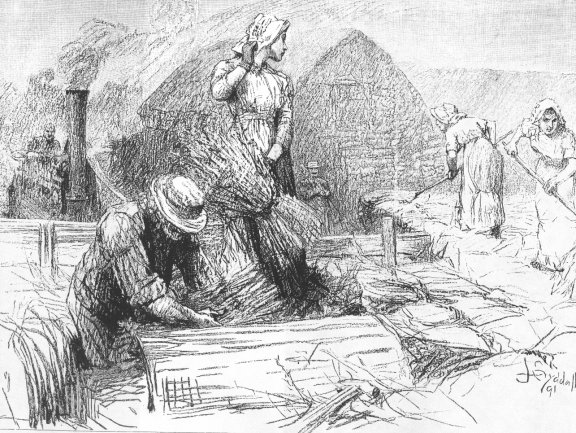
It was not until about three o'clock that Tess raised her eyes and gave a momentary glance round. She felt but little surprise at seeing that Alec D'Urberville had come back, and was standing under the hedge by the gate by Joseph Syddall. 16.2 cm high x 22.6 cm wide (6 ½ inches by 8 ⅞ inches wide), framed. This plate, which is number 20 in the serialisation of Thomas Hardy's Tess of the Durbervilles, illustrated by various artists, appeared on p. 633, Chapter XLVIII, in the 28 November 1891 issue of the London Graphic. [Click on the illustration to enlarge it.]
Passage Illustrated
In the afternoon the farmer made it known that the rick was to be finished that night, since there was a moon by which they could see to work, and the man with the engine was engaged for another farm on the morrow. Hence the twanging and humming and rustling proceeded with even less intermission than usual.
It was not till “nammet”-time, about three o’clock, that Tess raised her eyes and gave a momentary glance round. She felt but little surprise at seeing that Alec d’Urberville had come back, and was standing under the hedge by the gate. He had seen her lift her eyes, and waved his hand urbanely to her, while he blew her a kiss. It meant that their quarrel was over. Tess looked down again, and carefully abstained from gazing in that direction. [Book Sixth, "The Convert," Chapter XLVIII, 634; in the 1897 volume edition, 431]
Commentary: An Anti-pastoral Theme reified in The Graphic
This week's edition of the Graphic features two facing pages of three illustrations that complement Syddall's: the London gas-works (pipes, machines, and grimy navvies representing "the method of manufacture," pp. 644-645) and the massive group labour of Dragging the Lifeboat from Brighton to Portslade (632). Likewise in Sydall's jagged pencil sketch, the women are a physical extension of the agricultural machine, mere automatons who try to keep up with coal-fired boiler belching smoke. The operator is more demon than human, for he appears in the text, too, as "sooty and grimy," "a creature from Tophet" (633). Like his machine, the engine-man is not native to Wessex, as his "strange northern accent" underscores. The machine is a far greater threat to the pastoral world than the diminutive figure of the lecherous young squire, Alec D'Urberville (centre). He haunts Tess at her place of work, propositioning her. Abjuring his temptation, she has swung one of her heavy leather gloves gauntlet-like in his fasce, drawing blood.
Although Hardy refers to a "tight pinafore thing" that accentuates Tess's shapely form, Syddall shows nothing particularly fetching in either her face or figure as he holds a sheaf of hay while turning back at the barely sketched in Alec, his arms crossed. Syddall does, however, indicate Izz and Marian working on the corn rick with pitch-forks, stage left, which contribute to the picture's purgatorial feel. The curves of the female faces (particularly Tess's in the centre, her pillar-like form repeating the insistent vertical of the boiler's smokestack) contrast with the sooty engine and blackened, demonic operator to the left.
Note: The concluding illustrations in this serialised version of the novel are by different illustrators. For the complete list, see here.
Scanned image and text by Philip V. Allingham. Formatting by George P. Landow. [You may use this image without prior permission for any scholarly or educational purpose as long as you (1) credit the person who scanned the image and (2) link your document to this URL in a web document or cite the Victorian Web in a print one.]
Bibliography
Allingham, Philip V. "The Original Illustrations for Hardy's Tess of the D'Urbervilles Drawn by Daniel A. Wehrschmidt, Ernest Borough-Johnson, and Joseph Sydall for the Graphic (1891)." The Thomas Hardy Year Book, No. 24 (1997): 3-50.
Allingham, Philip V. "Six Original Illustrations for Hardy's Tess of the D'Urbervilles Drawn by Sir Hubert Von Herkomer for the Graphic (1891)." The Thomas Hardy Journal, Vol. X, No. 1 (February 1994): 52-70.
Hardy, Thomas. Tess of the D'Urbervilles in the Graphic, 1891, 4 July-26 December, pp. 11-761.
Jackson, Arlene M. Illustration and the Novels of Thomas Hardy. Totowa, NJ: Rowman and Littlefield, 1981.
Vann, J. Don. "Tess of the D'Urbervilles in the Graphic, 4 July 26 — December 1891." Victorian Novels in Serial. New York: MLA, 1985, pp. 88-89.
Created 21 January 2001
last updated 1 May 2024